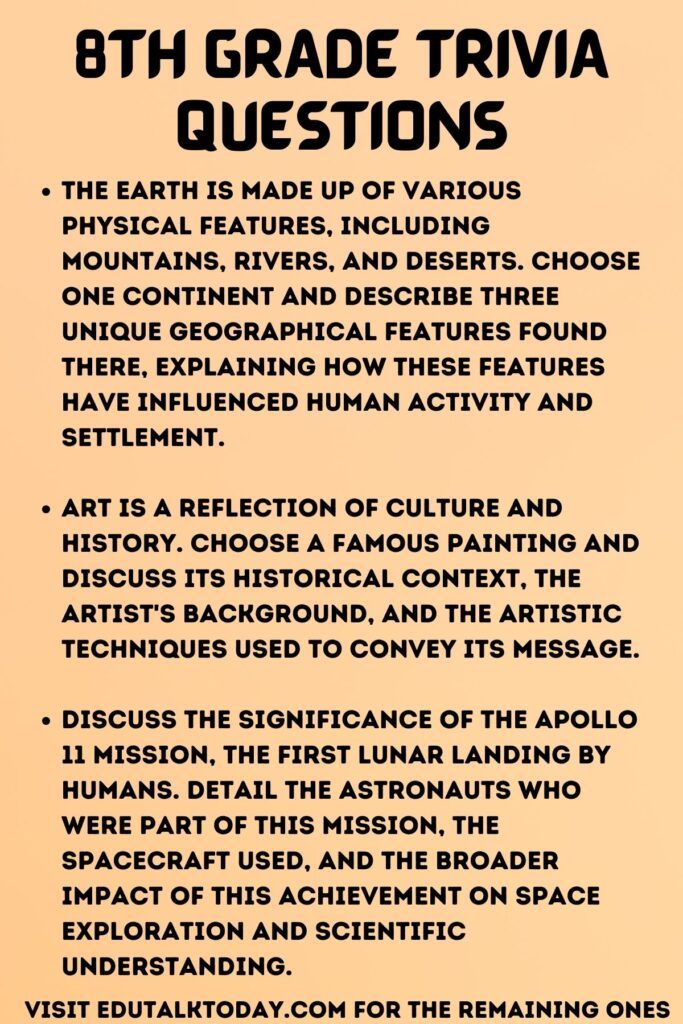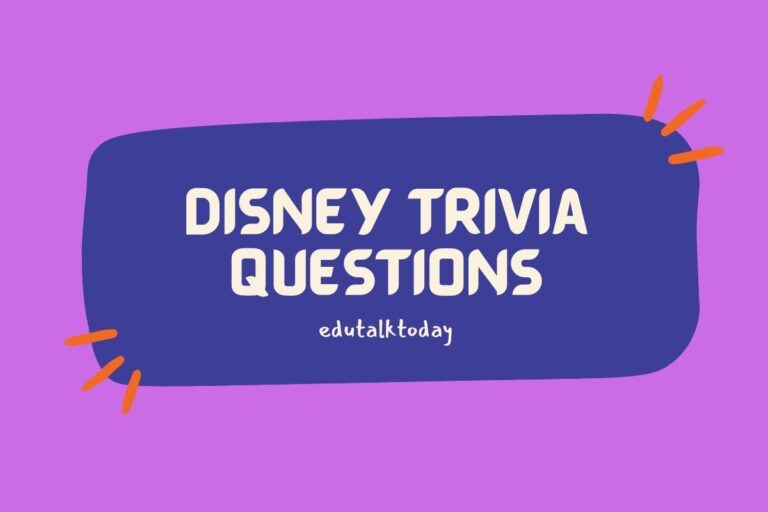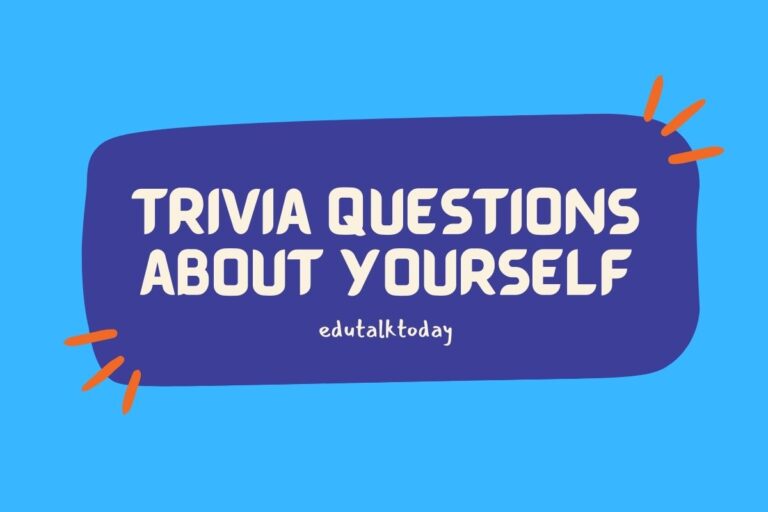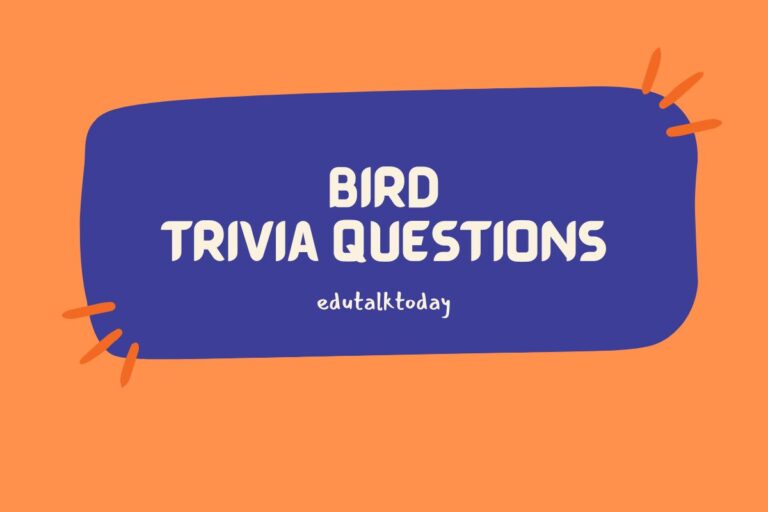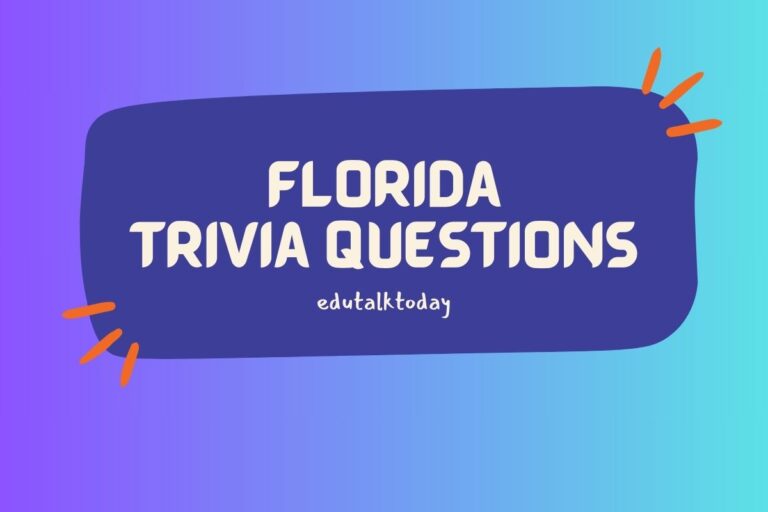34 8th Grade Trivia Questions

When it comes to engaging the minds of 8th graders, trivia questions can be an excellent tool. They not only provide a fun way to learn and review various subjects but also encourage critical thinking and teamwork.
These trivia questions for 8th graders cover a wide range of topics, from science and history to literature and pop culture. The variety ensures that students with different interests and strengths can participate and enjoy the challenge.
So without further ado, let’s explore them one at a time.
8th Grade Trivia Questions
- Astronomy Challenge: The Milky Way galaxy is a vast and beautiful array of stars, but it’s just one of many in the universe. Considering the types of galaxies observed in the cosmos, can you describe the differences between spiral, elliptical, and irregular galaxies, and also explain which type the Milky Way falls into?
- Historical Exploration: In 1492, Christopher Columbus embarked on a journey that would become a pivotal moment in world history. Detail the names of the three ships he commanded, the primary objective of his voyage, and discuss the broader impact of his exploration on global navigation and cultural exchange.
- Mathematical Puzzle: Imagine you’re designing a garden that includes a circular pond. If the diameter of the pond is 10 feet, calculate the circumference and area of the pond. Also, explain the mathematical formulas used to derive these calculations.
- Scientific Inquiry: Photosynthesis is a critical process for life on Earth. Describe the photosynthesis process in plants, including the reactants and products, and explain why this process is essential for both plants and animals.
- Literary Analysis: William Shakespeare’s play “Romeo and Juliet” is a timeless piece of literature. Analyze the central themes of the play and discuss how the concept of ‘star-crossed lovers’ has influenced modern storytelling.
- Geographic Expedition: The Earth is made up of various physical features, including mountains, rivers, and deserts. Choose one continent and describe three unique geographical features found there, explaining how these features have influenced human activity and settlement.
- Technological Evolution: From the invention of the wheel to the creation of the internet, technology has dramatically shaped human civilization. Discuss three significant technological advancements in history and their impact on society.
- Artistic Impressions: Art is a reflection of culture and history. Choose a famous painting and discuss its historical context, the artist’s background, and the artistic techniques used to convey its message.
- Government and Society: The United States Constitution is a foundational document in American history. Explain the purpose of the Bill of Rights, detail three specific amendments, and discuss how these amendments continue to impact American citizens today.
- Ecological Systems: The Amazon Rainforest is one of the most diverse ecosystems on the planet. Describe the concept of biodiversity, explain why the Amazon is so biodiverse, and discuss the importance of this biodiversity for the global environment.
- Physics in Motion: Newton’s Laws of Motion are fundamental in understanding physics. Explain each of the three laws and provide a real-world example demonstrating how each law is applied in daily life.
- Cultural Celebrations: The Chinese New Year, or Spring Festival, is a significant cultural event in China and worldwide. Describe the traditions associated with this festival, the significance of the Chinese Zodiac, and how this celebration reflects Chinese culture and history.
- Language and Linguistics: The English language is rich and varied, with words borrowed from many other languages. Choose three English words that originated from other languages, explain their original meanings, and discuss how their meanings or usages have evolved in English.
- Ancient Civilizations: The Egyptian pyramids remain one of the world’s greatest architectural marvels. Discuss the purpose of the pyramids, the methods believed to be used in their construction, and their significance in ancient Egyptian culture.
- Chemical Reactions: The Periodic Table is a crucial tool in chemistry. Pick an element from the Periodic Table, describe its properties, common uses, and discuss a chemical reaction it is involved in.
- World Religions: Buddhism is one of the major world religions. Outline the basic beliefs of Buddhism, the historical background of its founder, Siddhartha Gautama, and how Buddhism has influenced societies in Asia and beyond.
- Global Economics: The concept of supply and demand is essential in economics. Explain how supply and demand work together to determine market prices and give an example of how changes in supply or demand can affect the economy.
- Environmental Science: Climate change is a significant global issue. Explain the greenhouse effect, how human activities contribute to climate change, and discuss some of the potential long-term impacts of climate change on the planet.
- World Literature: “The Odyssey” by Homer is an epic poem that has influenced Western literature. Summarize the story, discuss the main themes, and explain how this work has shaped narrative storytelling and the concept of the hero’s journey.
- Human Anatomy: The human body is an intricate system. Describe the functions of the heart, lungs, and kidneys, and explain how these organs work together to maintain homeostasis in the body.
- Space Exploration: Discuss the significance of the Apollo 11 mission, the first lunar landing by humans. Detail the astronauts who were part of this mission, the spacecraft used, and the broader impact of this achievement on space exploration and scientific understanding.
- Classical Music: Ludwig van Beethoven is considered one of the greatest composers in history. Describe his contribution to classical music, including discussion of at least one of his famous works, and how his compositions have influenced the music world.
- Geology: Plate tectonics is a theory that has revolutionized our understanding of the Earth’s structure. Explain the theory of plate tectonics, how it accounts for geological phenomena like earthquakes and volcanic activity, and its significance in earth science.
- World Politics: The United Nations plays a crucial role in international relations. Describe the main purposes of the United Nations, how it operates, and discuss its role in addressing global challenges.
- Ancient Mythology: Greek mythology is rich with stories and characters. Choose one Greek myth, summarize its story, and explain its moral or the lesson it imparts.
- Computer Science: The development of the internet has transformed society. Explain the basic principles of how the internet works, including concepts like data transmission, IP addresses, and the World Wide Web.
- Historical Inventions: The printing press, invented by Johannes Gutenberg in the 15th century, revolutionized the way information was disseminated. Describe the mechanism of the original printing press, its impact on society, particularly on literacy and the spread of ideas.
- Botany and Ecology: The process of pollination is crucial for the reproduction of many plants. Explain how pollination occurs, the role of pollinators like bees, and the importance of pollination in ecosystems and agriculture.
- Astronomical Phenomena: A solar eclipse is a spectacular natural event. Describe what happens during a solar eclipse, the difference between total and partial eclipses, and important safety measures to observe while watching an eclipse.
- World History: The Renaissance was a pivotal period in European history. Discuss the key factors that led to the Renaissance, its impact on arts and sciences, and how this period changed the course of Western civilization.
- Physics and Energy: The concept of renewable energy is critical in today’s world. Describe different types of renewable energy sources, such as solar and wind, and discuss the advantages and challenges of using renewable energy.
- Literature and Symbolism: George Orwell’s “Animal Farm” is not just a tale about animals; it’s a complex allegory. Discuss the main themes of the book and how Orwell uses farm animals to symbolize different aspects of historical and political significance.
- Human Geography: Urbanization refers to the increasing population of people living in urban areas. Discuss the causes of urbanization, its impact on the environment and society, and potential solutions to manage urban growth sustainably.
- Art and Culture: The Renaissance produced some of the most famous artists in history, such as Leonardo da Vinci and Michelangelo. Choose one Renaissance artist, describe their most significant works, and discuss how their art reflects the values and aesthetics of the Renaissance.
Answers
- The Milky Way is a spiral galaxy, characterized by its flat, disk-like shape with arms spiraling outward. Spiral galaxies contain abundant dust and gas, elliptical galaxies are more rounded and have less dust and gas, while irregular galaxies lack a distinct shape.
- Columbus sailed with the Nina, the Pinta, and the Santa Maria. His primary objective was to find a western sea route to Asia. His voyages opened up the New World for exploration and eventual colonization, leading to significant cultural exchanges and navigation advancements.
- The circumference is approximately 31.42 feet (using the formula C = πd), and the area is about 78.54 square feet (using the formula A = πr², where r is half of the diameter). These formulas are fundamental in geometry for calculating properties of circles.
- In photosynthesis, plants use sunlight to convert carbon dioxide and water into glucose and oxygen. This process is vital for plant growth and provides oxygen and food sources for animals.
- Central themes include love, fate, and the feud between families. The ‘star-crossed lovers’ theme, depicting a destiny and society fighting against a passionate love, has influenced many modern romantic tragedies.
- [Student’s choice of continent]. The geographical features can range from mountains to rivers to deserts, each shaping human activities like agriculture, settlement, and culture in unique ways.
- Significant technological advancements might include the printing press (improving communication and knowledge dissemination), the steam engine (ushering in the Industrial Revolution), and the internet (revolutionizing information access and global connectivity).
- [Student’s choice of painting]. The analysis should include the period in which it was created, insights into the artist’s life and motivations, and the techniques and styles used that reflect the cultural and historical context of the artwork.
- The Bill of Rights constitutes the first ten amendments to the U.S. Constitution, guaranteeing fundamental rights like freedom of speech (1st Amendment), the right to bear arms (2nd Amendment), and protection against unreasonable searches and seizures (4th Amendment). These amendments continue to protect individual freedoms and influence legal interpretations.
- Biodiversity refers to the variety of life in an ecosystem. The Amazon’s biodiversity is due to its large size, varied habitats, and tropical climate. This diversity is crucial for maintaining global ecological balance, providing resources like oxygen, and supporting countless species.
- Newton’s First Law (an object in motion stays in motion), Second Law (Force equals mass times acceleration), and Third Law (For every action, there is an equal and opposite reaction). Examples include a ball rolling down a hill, accelerating a car, and the recoil of a gun when fired.
- Chinese New Year traditions include family reunions, red decorations, and fireworks. The Chinese Zodiac, a 12-year cycle with each year represented by an animal, influences people’s fortunes and personalities. These celebrations reflect the importance of family, tradition, and cultural heritage in Chinese society.
- For instance, “ballet” (French), “ketchup” (Chinese), and “sofa” (Arabic). Their meanings and usages have evolved significantly, adapting to the nuances and contexts of English.
- The pyramids served as tombs for pharaohs. They were likely built using a combination of manual labor and early engineering techniques. Their construction demonstrates the ancient Egyptians’ architectural skill and their beliefs about the afterlife.
- For example, Iron (Fe). It’s a metal with magnetic properties, commonly used in construction and manufacturing. In a reaction with oxygen, it forms iron oxide, or rust.
- Buddhism emphasizes the Four Noble Truths and the Eightfold Path, focusing on overcoming suffering and achieving enlightenment. Siddhartha Gautama’s teachings have profoundly impacted cultural, spiritual, and social practices in many Asian countries and have spread worldwide.
- Supply and demand determine the price of goods and services; when demand exceeds supply, prices typically rise, and vice versa. For example, a decrease in the supply of oil can lead to increased fuel prices, impacting transportation costs and the broader economy.
- The greenhouse effect is caused by greenhouse gases trapping heat in the atmosphere. Human activities, like burning fossil fuels, increase these gases, leading to global warming. Long-term impacts include rising sea levels, extreme weather events, and biodiversity loss.
- “The Odyssey” is about Odysseus’ journey home after the Trojan War. Its themes include perseverance, loyalty, and the struggle of man against the gods. It has influenced the structure of modern storytelling, particularly the hero’s journey archetype.
- The heart pumps blood, the lungs exchange oxygen and carbon dioxide, and the kidneys filter waste from the blood. Together, they maintain the body’s balance of oxygen, nutrients, and waste, crucial for overall health.
- Apollo 11, with astronauts Neil Armstrong, Buzz Aldrin, and Michael Collins, marked the first human moon landing in 1969. This mission, using the spacecraft Columbia and Eagle, significantly advanced human space exploration and scientific knowledge.
- Beethoven’s work, including symphonies like the iconic Fifth Symphony, pushed the boundaries of classical music. His compositions, characterized by emotional depth and innovative structures, have profoundly influenced music composition and appreciation.
- Plate tectonics describes the movement of Earth’s lithospheric plates. This movement explains the occurrence of earthquakes, volcanic activity, and the formation of mountains, significantly enhancing our understanding of Earth’s geological processes.
- The United Nations aims to promote peace, human rights, and development. It operates through assemblies, councils, and specialized agencies, playing a key role in peacekeeping, humanitarian aid, and addressing issues like climate change and health crises.
- [Student’s choice of Greek myth]. The story should be summarized, highlighting its key characters and events, and the moral or lesson, which often revolves around themes like the consequences of hubris or the value of wisdom.
- The internet works by transmitting data across a network of interconnected computers. Data is broken into packets, sent via various routes, and reassembled at the destination. IP addresses identify devices, and the World Wide Web provides a system for accessing and sharing information.
- Gutenberg’s printing press used movable type and a press mechanism, allowing for faster, more affordable printing. It greatly enhanced literacy and the spread of ideas, leading to the Reformation, Renaissance, and the scientific revolution.
- Pollination involves transferring pollen from the male part of a flower to the female part. Bees and other pollinators play a crucial role in this process. Pollination is essential for plant reproduction, biodiversity, and food production.
- During a solar eclipse, the moon passes between the Earth and the sun, casting a shadow on Earth. In a total eclipse, the sun is completely obscured, while in a partial eclipse, only part of the sun is covered. It’s important to use proper eye protection to view eclipses safely.
- The Renaissance began in the 14th century, driven by a revival of interest in classical philosophy and arts. It led to significant advancements in art, science, and thought, marking a transition from medieval to modern times in Europe.
- Renewable energy sources include solar (capturing sunlight), wind (using wind turbines), hydroelectric (using flowing water), and others. They offer sustainable alternatives to fossil fuels, though challenges include storage, transportation, and initial investment costs.
- “Animal Farm” explores themes of power, corruption, and inequality. Orwell uses farm animals to represent historical figures and ideologies from the Russian Revolution and subsequent Soviet regime.
- Causes of urbanization include economic, social, and environmental factors. Its impacts include increased demand for housing, transportation, and services, as well as environmental challenges. Sustainable urban planning is essential to manage these effects.
- [Student’s choice of artist]. Their works might include revolutionary techniques or subjects and often reflect the humanist ideals, technical mastery, and artistic exploration characteristic of the Renaissance period.
